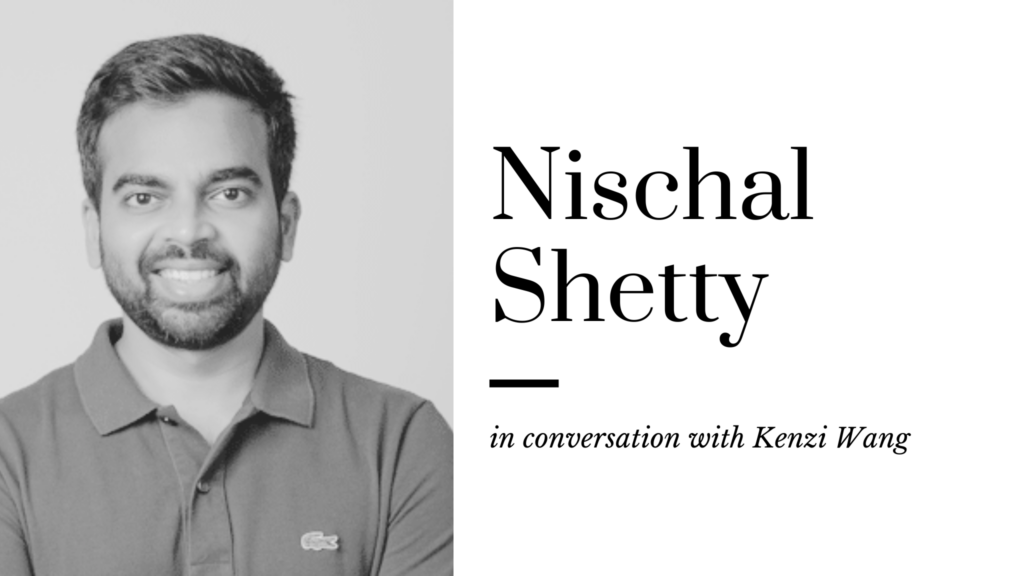“As a developer, if you build something in crypto, no one can come and tell you – “Hey, you can’t do this.” But, of course, later, I realized that governments can still do that. So decentralization attracted me, and I knew this is the foundation I want to build on.”
Building WazirX, India’s largest crypto exchange
In 2017, in India, if you wanted to buy Bitcoin, you would have to wait for a week. This is because the infrastructure for crypto was broken. So Nishcal decided that he would fix this problem, and he succeeded. By 2020, WazirX had become the largest crypto exchange; in 2021, the platform generated over $45 billion in trading volume.
“WazirX is still a centralized exchange. I aim to build something completely decentralized, and that’s what I’m moving towards.”
WazirX was not the first crypto exchange in India. It was the eighth or the tenth player to enter the market, but it bridged some existing gaps. The most significant gap was that most people didn’t trust the crypto ecosystem because there was no licensing. So anyone could start an exchange, shut down and run away with your assets. Also, none of the crypto founders were well-known. The second issue was that even in 2017 and 2018, even though India was a mobile-first market, there were no top-quality mobile apps in the space.
User Acquisition for WazirX
One of the biggest things WazirX got right was that it was deeply involved with the community and built the product with them.
“We do not wait for a launch date to announce a product. We involve the community on day 1, tell them what we want to build and why and then ask them for their input. We’ve had thousands of people doing beta testing for our exchange.”
The other big thing that WazirX got right is innovation. They’ve always seen a gap in the market and launched innovative solutions. In 2018, when banks were banned from allowing any transactions with crypto exchanges, many companies shut down and exited the market. WazirX launched a peer-to-peer method through which Indians could still buy cryptocurrencies through them.
Challenges of the L1 ecosystem
“The biggest problem of the layer one ecosystem we’re still facing is high fees and low scalability.”
High fees still exist because blockchains are not scalable, and transaction costs are high. Even if 1000 people want to run transactions, support is available only for 100, so the other 900 drop off. The available alternatives or layer two solutions are exchanges and wallets, which are not decentralized. There are currently 250 million people in the crypto ecosystem worldwide, which will go to a billion, but decentralization needs to be made accessible and affordable.
“Through sharding, we’re trying to give the world a scalable blockchain that everyone can adopt. Blockchain is definitely the future; we’re just trying to build a solution that the world wants.”
The attributes of a successful web3 entrepreneurs
“Hard work and perseverance are qualities you need to have irrespective of whether you’re working in web 2 or web3. But specifically for web3, the most important thing is to set aside this whole concept you’re building for yourself and a few people around you. Long-term web3 success is about losing power, not gaining power. You are not the center of attention.”
If you look at MAANG companies today, even though they are listed, because of the disproportionate amount of equity and power founders wield, they can decide where their companies go. Others have no choice but to accept this. In web3, even as the founder, you cannot make a difference alone. The majority of the community needs to come together if they want to change something. Also, in web 2, company information is not fully accessible to customers. Top management can choose to sugarcoat facts. In web3, everyone is at the same level and has the same information. Decentralization cannot be an afterthought or something that will happen eventually, it has to start from day one.
“There is no right or wrong way of doing things. Vocal and popular founders can be successful, and those who remain low-key. If you choose the first path, I would say that not just the founder but some key developers and users should also be well-known. No ‘one’ person should be able to weigh in and change things through influence. WazirX is centralized, so if I decide to change something, I can. But on Shardeum, I can only pitch my idea to everyone. It’s ultimately up to the ecosystem to accept my ideas or not”.
As per Nishchal, in Web3 it’s essential to build and distribute. You need to have people who can build solid technology and people who can distribute – it cannot be either/or. web3 teams need to have an equal proportion of these skill sets. Building in web2 and web3 is different. In Web2 it’s about applications and building fast. Once you’re at a certain level, you can always hire engineers to fix your problems. But with web3, it is key to have the right architecture from day one.
The best way to begin work in Web3, is just to jump in and start. One can always learn from peers and other companies. As a founder, the goal should be to keep the difference in information between internal teams and the community, to a minimum. The second thing is to address gaps in the market, but this does not mean identifying problems in Web 2 and then trying to implement the solution in web3. You have to start using web3 protocols, projects, and apps and find challenges that exist in this ecosystem. Using your Web 2 experience to find solutions in web3 will not work.
“The less you hide, the more popular you will be and the faster you will succeed in web3. Also, it’s a good idea to have a mentor and guide. It never worked out for me because I never found the right one, but you can save a lot of time if you have the right advisors. Another important thing to remember as a founder is to have a long-term plan for your startup. Many people spend too much money on the product and then have nothing left for marketing. Don’t do that. Have a phase-wise plan for your company.”
The downsides of Web3 and dealing with criticism
Nishal, with over 484k followers on Twitter, is among the most popular web3 founders in India. And while the sizeable online following has its advantages, it doesn’t come without problems. He faces his fair share of criticism online, but over time, he’s learned how to deal with it.
“It comes down to practice. You need to know who to listen to and who to ignore online. If my biggest customers were to voice an opinion, however harsh, I would take it serious versus some random person on the internet who probably doesn’t even know what I’m building.”
With decentralization, there will always be lots of questions about everything. Every stakeholder will raise questions about potential changes. When building something, you must stay focused and listen to the right people. The ones who want to give constructive feedback will rarely be harsh, even if they need to critique something. If the community is questioning something, many founders take that as a compliment and address the gaps.
The crypto landscape in India
There are 20 million people in India in the crypto ecosystem. The country has moved beyond the initial stages of essential knowledge and infrastructure. The next stage of mass adoption is here, we’re close to 250-300 million people can be brought into the crypto universe, considering that India has over 500 million internet users.
“There is going to be a high demand for new features, new protocols, and new startups to emerge which will solve for the Indian audience versus the first few waves of solutions in crypto which catered to global audiences.”
The Indian government’s policies on cryptocurrencies
From April 1, India
introduced a tax on all Virtual Digital Assets (VDAs). This means income from the transfer of VDAs in FY 2022-23 will be taxed at 30 percent with no deductions or exemptions. This has received a lot of criticism from the Indian crypto community, and many entrepreneurs are moving to cities like Dubai and Lisbon where laws and taxation are more amenable to web3 and crypto.
In India, crypto founders are facing a lot of issues. There are cases of these founders not getting bank accounts, not getting adequate funding because they’re based in India, funding getting blocked by banks because of their association with crypto, and salary payments to employees getting stopped.
Cryptocurrencies were never banned in India, but in 2018 there was a banking restriction on crypto companies. This meant that if you were a crypto startup, you wouldn’t get access to a bank account. On taxation, apart from the 30% tax on income from the transfer of VDAs, there’s also a 1% tax deduction at source if you’re going to do a buy and sell. The buyer needs to deduct 1% of the entire amount and pay that amount as tax. The buyer is eligible for a refund depending on his or her tax bracket. For high-frequency traders, this rule is causing a lot of liquidity issues. The other issue with the taxation rule is that one needs to pay 30% on profit from every trade. This means that if you make a loss on some trades, you cannot offset those. And at the same time, you pay 30% on all your profitable transactions which puts you in the highest income bracket in the country irrespective of your overall annual income and tax bracket.
“If governments were always afraid that they might do some wrong to the ecosystem, they would never be able to build a policy. I’m glad that no government has been right. So it’s not just India, but no government has been right. India has been harsher with the taxation but it’s okay. I think eventually they will get it right.”
But Nischal recommends that entrepreneurs should not move countries to build products for tax benefits because it is extremely disadvantageous to work in geographies that one does not understand. It also becomes difficult to move back to one’s home country after setting up abroad.
Misconceptions about Central Bank Digital Currencies (CBDCs)
“There are a lot of misconceptions about CBDCs. The biggest misconception is that central banks think that other cryptocurrencies will die if they launch a CBDC. That is not the case. A CBDC is a stablecoin with certain use cases, other cryptocurrencies have specific use cases that cannot be replaced. I think a better approach for governments would be to focus on digitizing physical currency.”
On the bright side, with the launch of CBDCs, crypto wallets will be adopted, and people will understand what blockchain and decentralization are. However, the launch of CBDCs is impeded by technological and implementation challenges. Banks can’t keep digital currencies secure, and there is also a lack of trained staff. In India, we’re unlikely to see CBDCs for another three to four years.
Inflection points in the Indian crypto ecosystem
The Indian media started talking about cryptocurrencies in 2017 and 2018, but at that time, much of the coverage linked cryptocurrencies with illegal activities. In 2022, the coverage is far more comprehensive, with in-depth analyses of NFTs and other aspects of crypto. The number of influencers in this space has also increased.
“Elon Musk definitely played a large part in India because many Indians follow him. And he started talking about Dogecoin, and people were having fun with it. With more VCs and more startups being built, awareness has increased. Government interest in crypto started in 2020 and 2021 and then because cryptocurrencies were being discussed in parliament, it was a factor that led to growth. The next inflection points will come with NFTs and solutions around remittances. We’re already at 20 million crypto users in India, and that number will skyrocket. Because of our demographics, we have a large number of 18-25-year-olds who don’t connect with traditional finance companies but are passionate about crypto and will fight for it.”
web3 developers in India
While the number of web3 developers in India is not enough, there has been a great increase compared to 2020 when only a handful of good developers existed. The fact that remote work has almost become the norm, is a great incentive for developers to experiment and learn new skills.
“In the next one or two years, I think web3 will also creep into the engineering syllabus.”
The current market cycle
“Not just crypto, but the overall macroeconomic conditions are such that all markets are going down. I don’t think we’ve hit bottom yet. The markets had become very frothy, and the fall will be gradual now. The startups building in this bear phase are really serious about their work. So I think some good quality startups will emerge during this period.”
Here is a list of the selected time stamps on the different topics discussed during the podcast:
00:58 – 06:22 – Nischal Shetty’s entrepreneurial journey
7:01 – 10:00 – Challenges of the layer one ecosystem
12:24 – 19:21 – Building WazirX
19:30 – 24:11 – The attributes of successful web3 entrepreneurs
29:08 – 32:00 – Dealing with criticism
35:25 – 38:08 – Getting started in web3
38:44 – 52:59 – The crypto landscape in India
52:59 – 57:44 – Misconceptions about CBDCs
57:44 – 1:04:54 – Inflection points in India’s crypto journey
1:09:25 – 1:12:49 – web3 developers in India
1:12:49 – 1:18:20 – The current market cycle
1:21:41 – 1:25:00 – Advice for founders



